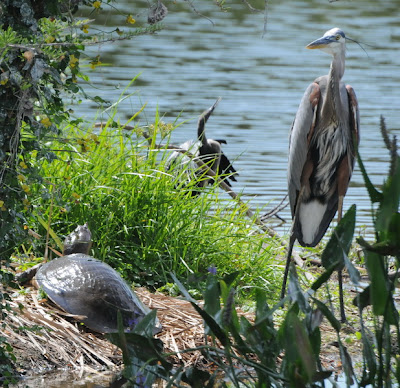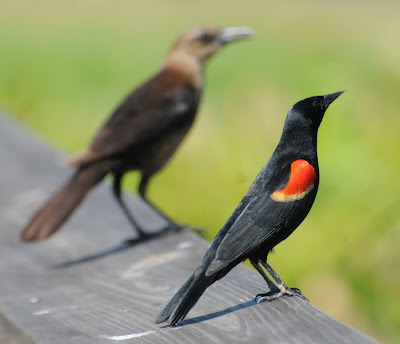As usual, we used the opportunity to take our morning walks - half constitutional and half birding for me, mostly exercise for Eileen - at our two favourite spots, the artificially constructed wetlands at Wakodahatchee and Green Cay, north of Boca in Delray.
Green Cay and Wakodahatchee are wonderful places to get face-to-face with wildlife.
Here, then, is a gallery of some of the creatures that let us (or my camera) get on close terms with them on our morning visits - sometimes in mixed-species lots. Here, from left, are a Florida Softshell Turtle (Apalone ferox), an Anhinga (Anhinga anhinga) and a Great Blue Heron (Ardea herodias).
Of course the star attraction for many of the visitors to the Wakodahatchee boardwalk is the American Alligator (Alligator misissippiensis). It's the biggest creature on either reserve (humans, perhaps, aside), but, frankly, during the day alligators don't seem to do very much. Certainly the Florida Red-bellied Turtle (Pseudemys nelsoni) in this photo doesn't seem the least bit concerned about the behemoth in front of him - the gator might as well be stuffed.
These Mottled Ducks (Anas fulvigula) don't seem too concerned about alligators either.
More active are the Florida Softshells, the second-largest reptiles in the wetlands except for the odd feral Green Iguana (Iguana iguana) or, perhaps, a Burmese Python (Python bivittatus) should any of these exotic menaces reach the area. Let's say, the second-largest native reptiles. I suspect, too, that they second only to the alligators in the ferocity of their bite should you try to disturb them.
We see Florida Water Snakes (Nerodia fasciata pictiventris) far less often, but they must be common in the area.
Alligators aside, birds usually get the most attention from - and, frequently, seem to pay the most attention to - human visitors. This Double-crested Cormorant (Phalacrocorax auritus), apparently a first-year bird, could hardly have been more approachable. Note the turqoise-green eye!
This cormorant may look as though it is about to pounce on a seemingly-unsuspecting Black-necked Stilt (Himantopus mexicanus), but it is really just taking a bit of sun.
This Great Blue Heron is doing the same thing.
This Tricolored Heron (Egretta tricolor), though, really is getting ready to pounce - or looking for an opportunity to do so. Tricolors regularly hunt their prey with their wings held open - perhaps to shade the surface of the water, or perhaps to startle prey as the bird darts to and fro, or perhaps for some other reason (it has been suggested that the shade of the bird's open wings may even attract small fishes, though you might expect for that to work the bird would have to hold very still. It doesn't).
This Green Heron (Butorides virescens) is opening its wings for a far more prosaic reason: a nice, thorough preen.
At Green Cay we encountered the full gamut of heron sizes, from the biggest, the Great Blue Heron…
to the smallest, shyest and hardest-to-see of the lot, the Least Bittern (Ixobrychus exilis).
Not a heron, but a distant heron cousin: a Glossy Ibis (Plegadis falcinellus).
The Black-winged Stilt seemingly being menaced earlier in this post is a species we often miss in the wetlands, as it usually vacates the premises for the winter. By April, however, the stilts were back, giving us a welcome opportunity to become re-acquainted with these lovely birds.
Another candidate for the most beautiful water bird in the area, the Black-bellied Whistling-Duck (Dendrocygna autumnalis), is a recent arrival in South Florida that has now become a common sight at both Green Cay and Wakodahatchee.
Certainly the most brilliantly coloured waterbird in the area is the American Purple Gallinule (Porphyrula martinica). Largely, but not entirely, a vegetarian, it spends much of its time clambering more or less acrobatically above water level. Here, it looks for flower buds, seeds and other suitable morsels both plant and animal, including insects hiding among the leaves of aquatic plants.
Red-winged Blackbirds (Agelaius phoeniceus) are everywhere in the open marshlands, and the males find the boardwalk guardrails to be ideal singing posts. They are usually far too busy challenging rivals to worry about human photographers. The out-of-focus brown bird behind the redwing in the upper picture is a female Boat-tailed Grackle (Quiscalus major).
in general, songbirds and other small birds stick to the tree-covered dikes between the settlement ponds. I found this male Downy Woodpecker (Picoides pubescent) at Wakodahatchee.
\
The Fish Crow (Corvus ossifragus) is usually the only crow to be found near South Florida's East Coast. This appears to be one, but I confess I find the species very difficult to identify unless the birds are either calling or traveling in a flock. The Fish Crow, unlike the American Crow (Corvus brachyrhynchos), is a highly social bird.
Migrating and/or wintering warblers are also to be found exploring the bushes along the edge of the wetland ponds. This is a Northern Parula (Parula americana).
At the entrance to Green Cay, there is a small hardwood hammock with a few bird feeders. This is usually a good place to find White-winged Doves (Zenaida asiatica), a species that was deliberately introduced to the state in 1959, although naturally-occurring birds do show up in Florida during fall migration.
The same feeder that attracts the doves is also frequently visited by Hispid Cotton Rats (Sigmodon hispidus). Unlike most other mice and rats, the Hispid Cotton Rats can be active at any hour of the day, so seeing one in broad daylight isn't too surprising. The word "hispid" means "covered with stiff hair or bristles", though in this case the cotton rat seems to have earned the name because the colours of its body hairs vary from tan to brown to black, giving its coat a coarse, or hispid, appearance.
Raccoons (Procyon lotor) are a common sight here, too.
Finally, for those who find reptiles, birds and mammals too large to deal with, there are attractive butterflies like this Julia (Dryas iulia).
There are also some highly impressive spiders. This is a Golden Silk Orbweaver (Nephila clavipes): not, perhaps, everyone's favourite, but a beautiful and exotic creature to me, and, in my opinion, a good one to end on.

.JPG)
.JPG)
.JPG)
.JPG)
.JPG)


.JPG)
.jpg)
.JPG)
.JPG)

.JPG)
.JPG)
.JPG)
.JPG)
.JPG)
.JPG)
.JPG)
.JPG)
.JPG)
.JPG)
.JPG)
.JPG)
.JPG)

.JPG)
.JPG)
.JPG)
.JPG)
.JPG)
.JPG)
.JPG)
.JPG)
.JPG)
.JPG)
.JPG)
.JPG)
+.JPG)
+.JPG)
No comments:
Post a Comment